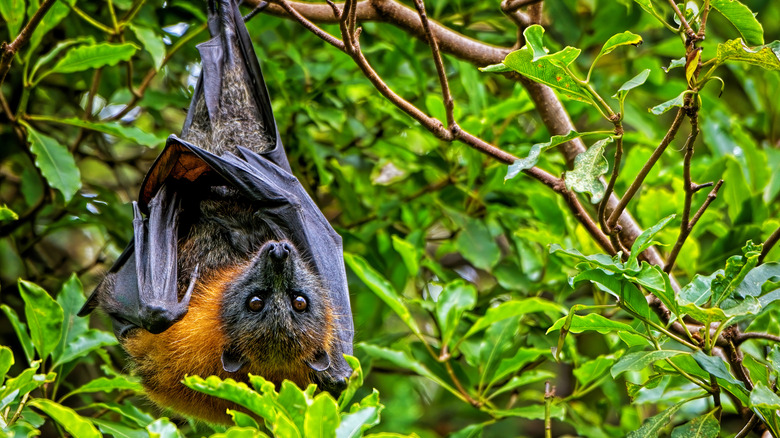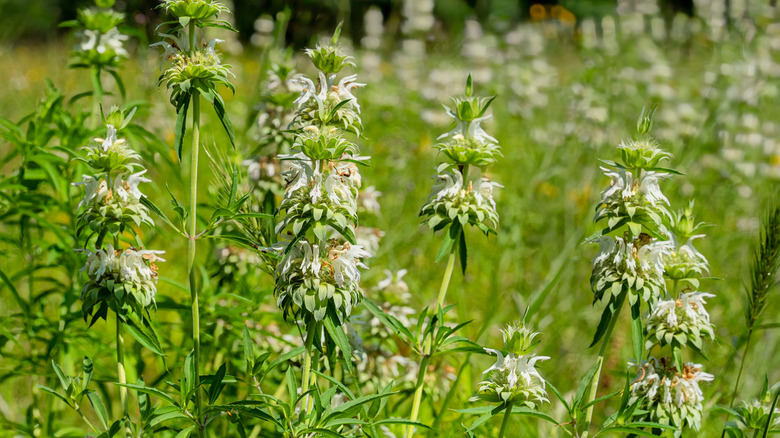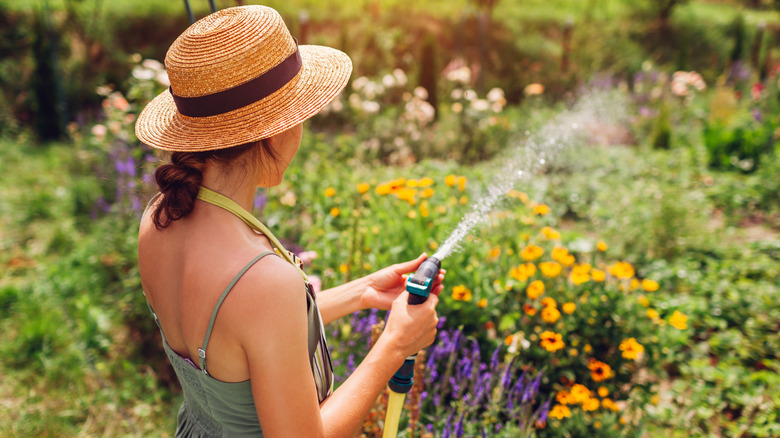The Flower With Colorful Blooms That Can Attract Bats To Your Yard
When you picture bats scattered around your garden, your mind might immediately jump to spooky folklore or festive Halloween decor. But in reality, bats are one of the hardest-working nighttime visitors that you can hope to host. They feast on mosquitoes, moths, and other pests, providing natural pest control without extra effort on your part. A single bat can consume thousands of insects in just one evening, saving you from mosquito bites and reducing the need for potentially harmful chemical sprays. Beyond bug management, their pollination work helps plants thrive – much like bees and butterflies, but under the cover of night. When it comes to creating a more balanced, biodiverse garden, inviting bats into your space is a win for you and the ecosystem.
One surprising way to bring bats closer is by planting flowers that appeal to their nighttime feeding habits. That's where spotted bee balm (Monarda punctata) comes in. Also known as horsemint, bee balm produces nectar-rich, light purple blooms that catch the attention of hummingbirds by day and bats by night. It has a long blooming period to show off its architectural flowers that attract all sorts of pollinators, ranging from bumblebees, wasps, butterflies, and even bats. The plant's strong oregano scent can help guide nocturnal visitors well after the sun has set. In addition to being beautiful and fragrant, bee balm thrives across USDA Zones 3 through 9, tolerates a range of climates, and typically blooms from summer through early fall. That means you're not just planting for looks — you're creating a reliable food source that keeps wildlife coming back season after season.
The benefits of spotted bee balm in your garden
Spotted bee balm isn't just attractive — it serves double or even triple duty in your garden. For starters, those vibrant blooms offer an enticing nectar source for bees, hummingbirds, and bats – meaning your garden becomes a hub of pollinator activity throughout the season. Few plants attract both daytime and nighttime pollinators, making spotted bee balm a true standout. The plant's fragrant leaves, often described as fresh oregano, can be harvested for teas and herbal remedies. Spotted bee balm has a long history in traditional medicine, used to soothe headaches, fevers, and fungal issues, making it as useful indoors as it is outdoors. Gardeners who appreciate multi-purpose plants will find bee balm a standout that combines beauty and utility.
On the ecological side, bee balm has the power to transform how your garden functions. Its pollinator-attracting capability encourages cross-pollination, which leads to bigger harvests if you're also growing fruits and vegetables nearby. Additionally, this perennial spreads steadily, making it an excellent choice for filling in bare patches of soil and creating lush, full garden beds over time. Because it's hardy and adaptable, bee balm fits into a wide range of garden designs — from cottage-style flower beds to structured pollinator-friendly borders. It pairs beautifully with other perennials like smooth aster, foxglove, or black-eyed Susans, creating a layered, textured look that blooms for months. The result is a plant that doesn't just sit pretty, but works quietly behind the scenes — even at night.
How to keep a bee balm plant looking vibrant
Despite all its benefits, spotted bee balm doesn't demand much in return. The perennial thrives in full sun, but can tolerate partial shade, making it flexible in terms of placement. The key is planting it in sandy, well-draining soil that stays consistently moist but not soggy. Adding compost or organic matter at planting time gives it the nutrient boost it needs to establish strong roots. Once settled, spotted bee balm typically requires little maintenance beyond watering during particularly dry spells. Deadheading spent blooms can extend the flowering season, rewarding you with fresh lavender flowers well into late summer.
Unlike many members of the mint family, spotted bee balm spreads by taproot rather than rhizomes. This means that it won't quickly spread out of control and overtake your garden — a problem common with other bee balm varieties. The plant will reproduce using seeds that are inexpensive and accessible, but you can let nature work and allow your plant to reproduce naturally. Powdery mildew is the most common problem to watch out for, especially in humid climates. You can prevent powdery mildew by spacing out plants properly and ensuring good airflow.
To go a step further in creating a bat-friendly habitat, pair spotted bee balm with other nectar-rich night bloomers like evening primrose or moonflower, which glow after sunset and guide bats to your yard. Installing a simple bat house nearby provides safe shelter, while a shallow birdbath or small water feature gives them a much-needed drinking source during warm nights. Deer and rabbits typically avoid bee balm, so you can confidently plant it as part of a larger, wildlife-friendly design. Overall, bee balm anchors any garden as both a visual highlight and a practical ally, helping you build a space where bees, bats, butterflies, and people can thrive together.


